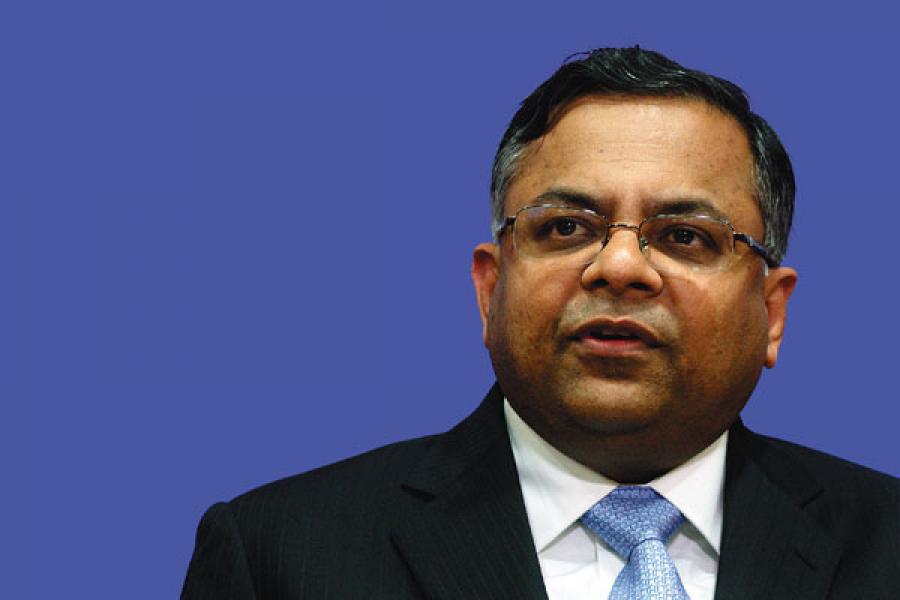
The Techtonic Shift in Indian IT
How the Indian Infotech industry will survive and thrive
The life of 30-year-old Wael Ghonim has a strange parallel to those of N. Chandrasekaran, Kris Gopalakrishnan and Francisco D’Souza. There was a time when each one of them was a bystander to a revolution.
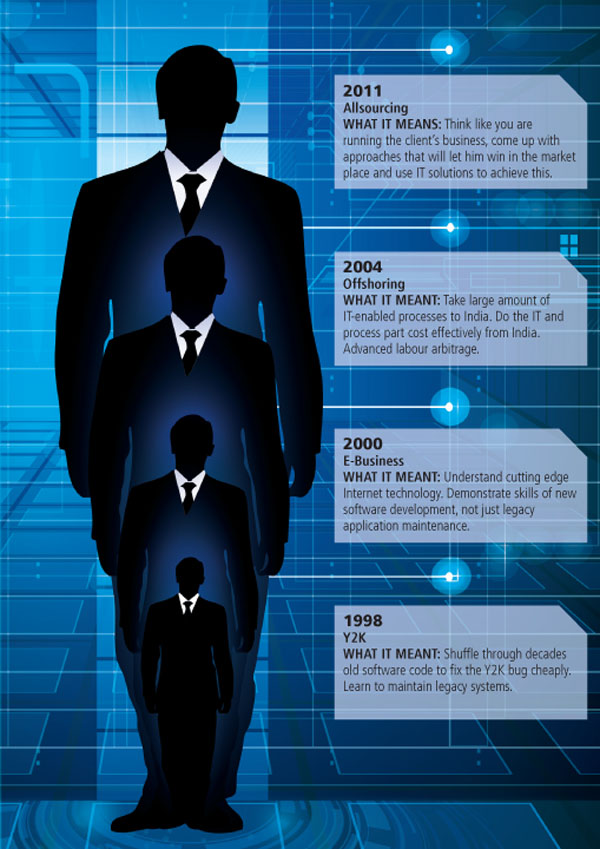
Ghonim, a Google executive, had come back to his native Egypt in early January but disappeared on January 27 and spent the next 11 days in secret police detention. Upon his release on February 7, he was interviewed on TV in which he denied he was the real hero. He walked off the camera, but not before declaring that he would never leave Egypt and that he was ready to die for its cause.
Political revolutions are poetic and technology revolutions prosaic but both are about creative destruction. Both change the way we live. And often it is the bystanders whose commitment decides the success of such revolutions.
Nearly a decade and a half ago, N. Chandrasekaran, then in his early thirties, must have felt the same; or for that matter, the 40-something ‘Kris’ Gopalakrishnan must have too. Though TCS that Chandrasekaran heads, or Infosys that Gopalakrishnan runs today were central to the revolution in global technology even that time, all that they got for their labours was the tag “Code Coolies”. The revolution belonged to IBM, Sapient, Cisco, and Netscape. Chandrasekaran and Gopalakrishnan were not much more than bystanders.
But at the beginning of 2011, their companies are much, much stronger and on the verge of driving a brand-new IT revolution that will yet again change the way we live and work.
To understand this, you would have to make the trip to the faraway American Midwest. There lies Jane or Jenny — names are not that important here — ailing and at home. With American healthcare in shambles, getting nursing help at home is tough. The number of available nurses is no match to the number of patients needing them. Many patients flock to the hospitals, naturally. It is then that the law of unintended consequences kicks in and those who actually need the hospital beds find it hard to get in. Hospitals face a moral dilemma. How can they nurse the ailing as far as possible in their own homes so that hospital beds are free to take in the more critically ill patients? Obviously, they can’t hire a large nursing field force. The costs are prohibitive and the task of managing them is quite another matter altogether.
That’s when the bystanders of the last revolution decided to step into the square. The company, possibly Cognizant, perhaps Wipro, decided to speak up and offer to save those lives. As per the plan, the best nurses go out into the field armed with hand-held devices, nifty software and high-speed connectivity. The field nurses provide the human touch, the panacea of the ailing. All the vital signs and medical data they gather are divided into two batches. The batch of data which needs immediate action — for instance, a suspicious change in the ECG pattern — is analysed at a local command centre. Everything else is sent to a centre in India where it is put into a database and analysed for long-term action.
The Indian outsourcing company owns and operates everything, nurses in the field, US operations centres, India operations centres and all the IT and infrastructure. It builds the business by acquiring, integrating and transforming the various assets required. It adds more sophisticated local-market call centre services for practicing nurses in the field and buys out companies with field nursing staff. Now, a complete home nursing solution can be offered to health-care providers or health plans, all from workstations in India.
A decade ago, the Indian company would have been merely fixing bugs in the hospital software.
Today the world wants Indian IT companies to go beyond offshoring. Global customers appreciate that Indian companies understand technology and know how to cut costs. And that they could help cut costs down to the bone. Gone are the days when companies could just fill in the technology piece and smugly make money. Now, the overseas customers want Indian outsourcing firms to help them evolve business solutions.
“Fundamentally if they don’t understand our business, they wouldn’t be on board at all,” says the CIO of one of the world’s largest companies. So, the changing reality for Indian companies is to take the next logical step and align their services more in tune with the business objectives of their customers. This is especially true of large companies like Tata Consultancy and Infosys who have the capacity to undertake enterprise-wide projects and urgently need ways to get their massive revenue bases to grow.
This in itself would be a tough enough challenge. What makes the job tougher for Indian companies is that there is a new clutch of technologies they need to master — social media and cloud computing. If they are smart about it then this is the moment when Indian firms can wrest the technology thought leadership from companies such as Accenture, IBM Global Services and HP.
Why the West Will Be Won
How did we get here? Something has changed after the economic coma of 2008. Talk to large IT companies, small IT companies, mid-sized IT companies, the ones based in India or in the US, you get to hear the same refrain: Every client is under pressure to increase revenues, businesses are more dependent on technology than ever before, and they want their suppliers to come up with solutions without asking for more budgets.
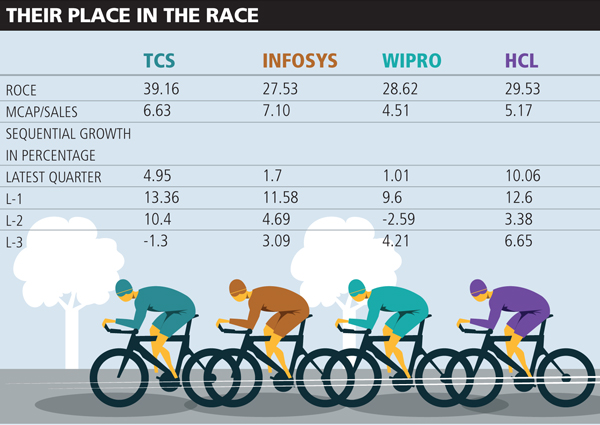 Take for instance Eli Lily, the $21.8 billion pharmaceutical company. It wants to cut down sales and marketing costs. It also wants to pay for only what it uses without losing the richness of data capture. Cognizant today runs Eli Lily’s entire sales force reporting and management on the cloud and charges them according to the usage.
Take for instance Eli Lily, the $21.8 billion pharmaceutical company. It wants to cut down sales and marketing costs. It also wants to pay for only what it uses without losing the richness of data capture. Cognizant today runs Eli Lily’s entire sales force reporting and management on the cloud and charges them according to the usage. 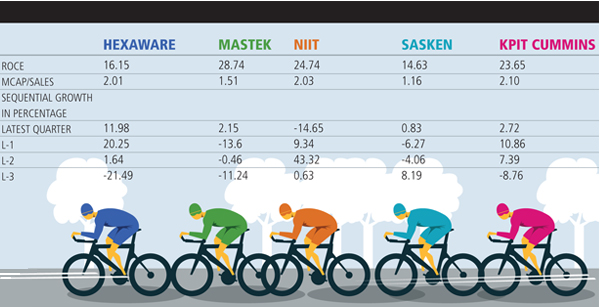 Infographic: Sameer Pawar
Infographic: Sameer Pawar Ever since 2001, IT has been used mostly on improving operations. A lot of that automation has worked. Naturally the CIO has to move towards projects that give his company a competitive edge. “Earlier, when you forgot your password, you would call the help desk. Today, the system generates a new password. The CIO will, in the future, spend 80 percent to transform and only the rest to maintain,” says Rajiv Sodhi, Chief Customer Officer of HCL Technologies.
Now there is a renewed focus on using technology to create new business models. Why? Two reasons. The first reason is that for the basic services that don’t add to competitive edge — for instance bank reconciliation — customers will keep driving costs down. “Large Fortune 100 companies in many areas like financial services or telecom totally understand the pricing of basic services,” says Peter Lowes, principal, Deloitte Consulting. There are so many sourcing professionals out there today that the customers know whether a vendor is providing service at a good price or not. So some of the new technologies — cloud computing for instance — will be used to crash costs in those areas.
The second reason is that end consumers are themselves migrating to new channels. Businesses have to go where the consumers are going. Companies desperately want to make sense of all the chatter on Twitter and Facebook to market to users. For instance, people discuss their favourite films, books, music on their Facebook accounts. Could that information be used to sell to them? IT firms that can figure a way around the social media maze and connect them seamlessly to corporations will be clearly in demand.
The Inflexion Point
The importance of this moment cannot be exaggerated. The last such change came about in 2004 when the offshoring became mainstream. This allowed Indian companies to snatch business from IBM, Accenture, Cap Gemini, EDS, CSC and go directly to the client. And here is the thing about such technology waves. While they last for five to seven years, the maximum gains go to companies that capitalise on it in the first year or two. IT business models like financial products can be copied and replicated easily. Once a company sets up a Facebook store, it will be replicated in a matter of months. A media company decides to set up an iPad application. How long do you think before it will be copied? A few months! So the IT firm that develops the first Facebook store or the first iPad application pockets a disproportionate amount of revenues and profits. Everybody else picks up the dimes from the ‘long tail’.
Consider the Offshoring Wave of 2004. That advantage lasted for about two years and by 2006, almost all global majors had set up shop in India. By 2007, they were able to understand offshoring and also deliver cost competitive services.
Then the overseas MNCs went a step further. IBM grabbed the Airtel deal and HP grabbed the Bank of Baroda deal. “These companies then bagged multiple projects in those industries and dominated the space,” says Navneet Vashisht, principal for technology, media and telecom practice at Boston Consulting Group. Barring TCS and Wipro which already had a significant presence in the Indian market, the rest of the Indian companies were unable to make any headway in the local market.
So now the customers are willing to look at Indian companies as well and this much vaunted “climb-up-the-value-chain” moment has arrived. The chief information officer of a Fortune 50 conglomerate says that these days, Indian companies often have more business ideas than the MNC giants. “I am sometimes disappointed that our own managers are not able to use the high value ideas from Indian companies. When I ask why, I’m told they are afraid of losing their jobs,” he says. The encouraging part is that most global clients would happily line up a TCS or Wipro against IBM, Accenture or a Perot Systems any day now. What the Indian guys need to do is to sharpen their sales pitch, something they don’t always do well.
The Scenery Changes
The new landscape is clearly being driven through two axes. The first axis is that of technology. The arrival of new technologies like mobility, cloud and social media means Indian players have to figure out new business models that their clients can use to compete.
Take for instance what Wipro, Cognizant and TCS are doing in this area. Wipro is now marketing a solution where the patient can take his blood sample and combine it with an iPhone application and send it to the doctor. “In the US, you have to take the prescription from the doctor and go to the pharmacy. Now we have a mobile application where you can take the prescription, upload it over the cloud, it goes to the pharmacy and medicines will be delivered home,” says Rajan Kohli, head of marketing at Wipro Technologies.
Cognizant’s idea is around the impact of social media on banking. “The millenial [young] customers don’t like going to the bank or insurance company, so we are helping the bank create new channels for servicing these customers,” says Malcolm Frank, the company’s chief strategist. Just a few weeks ago, TCS created a cloud platform called iON for small and medium businesses in India. Clients get access to basic accounting and sales software for which they can pay on a monthly basis. This allows customers to pay as they use but also creates a business model that allows TCS to sell its services at a price affordable in emerging markets. If it works in India, the model will go to other emerging markets. TCS already has 100 customers. It hopes to get a thousand in five years and revenue of $1 billion from this service offering. Arup Roy, senior research analyst at Gartner, says that new disruptive technologies like cloud computing, and software or infrastructure as a service, could open up an opportunity as large as $125 billion for services companies in the next decade.
Notice another common feature. All the companies are investing in the solution before they make their first sale. “The walk in business is not what we are going after, it is the demand that we create for these new solutions that is now the main driver,” says Kohli of Wipro. This is a huge shift for an industry that is used to working as a daily wage earner.
The second axis of competition will be how companies choose their portfolio and how they organise themselves. For instance, TCS and Infosys figured out years ago that financial services is a great business. IT budgets are bigger since, for banks and financial institutions, technology is a strategic advantage. Cognizant is strong in banking, financial services and insurance, and in healthcare. Healthcare spending is expected to accelerate in the coming years and companies that have a strong business in this area will do better than the others. “People who break into new industry like mining or even military will enjoy first mover advantage,” says Lowes. Some of these choices may mean using an India-plus strategy for locating some part of the work force. “You have to be where the customer is, especially for sensitive sectors,” says V.S. Krishnan, former chairman of HCL Technologies (Europe) who now advises companies, including some medium-sized ones.
And companies won’t be able to look over each other’s shoulders and copy options. “In 2005 there was hardly any difference in the operating models of the tier 1 companies but in 2013, you will see a distinct shift in their operating models. This is the time when each one of us needs to make distinct choices of the areas we will invest in,” says Frank.
Along with a choice in industry areas, companies will also need a more efficient structure to compete. TCS symbolises that. In 2008 they began a reorganisation and today TCS is divided into approximately 10-12 units each focussed on a certain set of clients and each of them earning a revenue of $400-600 million. The individual groups are technology and platform agnostic. If the client wants infrastructure services, he gets that; if he wants end-to-end BPO platform, that too is available. “The groups allow decision making to flow down the line and help it happen faster. We also have total view into the customer account,” says N. Chandrasekaran, TCS CEO.
The earlier approach of industry and technology practices was a silo-based approach and that is not suitable for a company that is looking for every opportunity to increase its business with the customer. Most large companies will have to see whether the organisational structure they have now will serve them under the new regime.
Medium but Not Mediocre
All this doesn’t apply to the small and medium-sized companies that have been waiting for the tailwinds to help them grow bigger. “Imitating Infosys will not work. That game is over,” says Rajiv Kaul, executive vice-chairman and CEO, CMS Infosystems. The problem for all these companies is that the cost of sales has gone up. Today winning a $1 million new account costs around $250,000 in sales costs. In comparison, a large company like TCS needs just $2 million to service and maintain an existing $100 million account. Most medium-sized companies simply lack the scale to be able to absorb the costs.
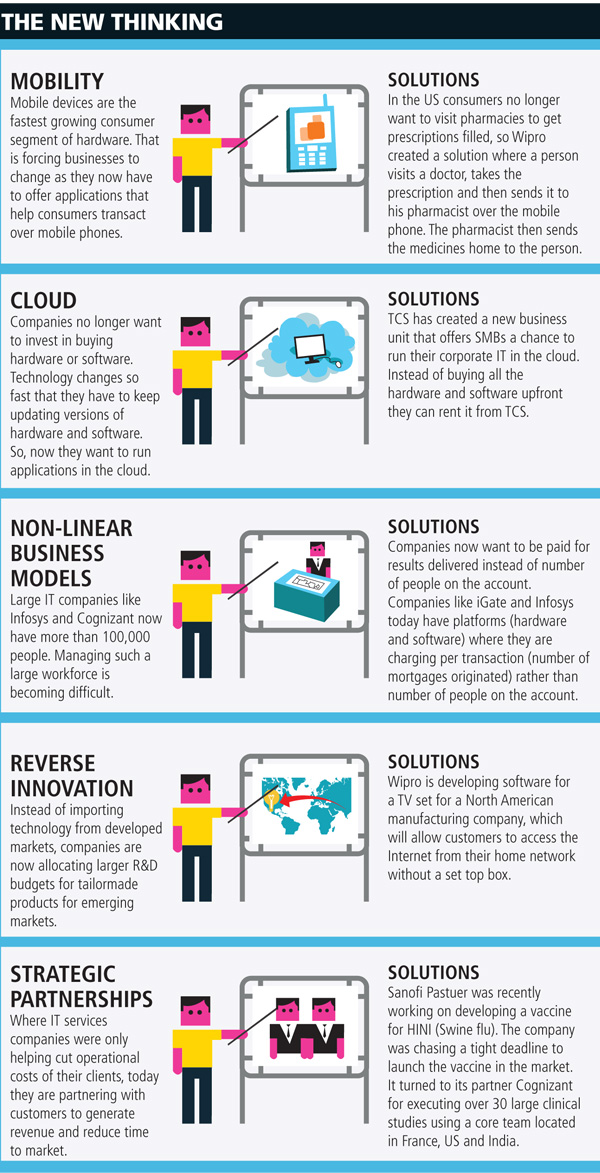 Infographic: Sameer Pawar
Infographic: Sameer Pawar What can they do? Mohan Shekar, who was the head of delivery at Infosys for many of its growth years, says the short-term solution lies in chasing revenue growth and doing whatever the client wants you to do. Shekhar is now the COO at a mid-sized company Collabera, which he says grew 28 percent last year and had a revenue base of $350 million. He says his strategy is to look at areas where the Indian tier 1 companies do not operate — such as consulting, onshore projects and staff augmentation — and grow that aggressively. “Even though my margins are lower, I’m creating shareholder value because I’m growing faster than all my peers,” he says.
There is a McKinsey report on ‘Granularity of Growth’. It analysed 500 companies over two decades and found out factors that influence growth. These were through portfolio momentum (48 percent), M&A and JVs (30 percent) and through operational efficiency. Mid-sized companies will have to clearly pick three or four industries and focus deep there. And companies that are growing fast in this band are all doing it. L&T infotech is focussing on Oil & Natural Gas. KPIT Cummins is going for automotive. NIIT Technologies is picking travel, insurance and cargo. Hexaware is focussing on capital markets, a sub-segment of financial services and also using its strength in Testing. But all these players will have to use the momentum they get to acquire and get scale in their area of expertise.
The advantage that they have is inherent in the structure of the industry. “Not every project needs 2,000 FTEs, some need 150-200 FTEs, where we can compete very comfortably,” says Sudip Banerjee, CEO, L&T Infotech. (FTE is Full Time Equivalent, a measure of working hours.) It is a highly fragmented industry and all customers want to be the ‘top dog’. The quality of interaction with the customer could be the most significant differentiator for a smaller company.
“The good news is that there is a huge switching cost. So unless a company is doing something really bad, the client doesn’t move his business out,” says Shashank Singh, co-lead, India at Apax Partners that recently invested in iGate. That said, if the quality isn’t good, the quantum of business does not go up either and that has a debilitating effect on talent retention. Most medium sized companies, when they stop growing, lose their best talent. So medium-sized companies that are today selling the story of specialisation need to understand that growth is not an option and that specialisation is at best a tactic. As a long-term strategy that would be suicidal.
The advice of most financial investors to medium-sized companies is to bite the bullet and sacrifice some profit margins to invest ahead of time, just like Cognizant did; build out campuses and invest in sales and marketing organisation to grab new business. Even though they can’t be the next Infosys, who knows, they could be the next Cognizant.
(This story appears in the 11 March, 2011 issue of Forbes India. To visit our Archives, click here.)
-
 Prateek Narang
Prateek NarangWill it ever be possible when dependency on the west is over and Indian IT industry gets recognition for the solutions developed for our own need and required all over the world!!!! Prateek http://prateeknarang.blogspot.com
on Mar 11, 2011 -
 Garry
GarryIt may not be that rosy for Indian IT, as written in this article. Non-linear growth is only being talked about and not implemented yet. Currency fluctuations affect the margins. Geopolitical concerns could play spoilsport; protectionism in US and Europe in the form of visa restricitons and taxations.
on Mar 8, 2011
